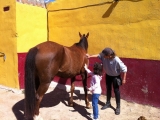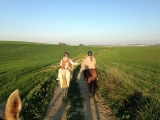The adventure sports have numerous professionals who have impeccable track records. The world of horses could not be less, offering us stories such as those of the Italian rider Federico Caprilli, considered by the prestigious magazine L'Année Hippique as the best show jumping rider of the 20th century.
It is undoubtedly difficult to establish criteria to choose the best rider of a century, since not only is it a very long time but there are very variable criteria and circumstances. Of Caprilli, without a doubt, it can be assured that his theories, which he and his disciples put into practice and which still exist, absolutely changed show jumping to horse.

Historical antecedents to Caprilli
To fully understand the revolution that Caprilli represented in horse riding, we must go back in history and briefly remember the ancestors of the Italian rider.
In the 16th century Antoine de Pluivinel, a follower of the methods of Pignatelli and Grisone, advocated softening aids and tried to be more understanding with horses, but his theories were still based on works exclusively in riding arenas and used the pillars, which even then, in the opinion of many, restricted the horse's progress, and although not without great sensitivity and great knowledge, he practiced a horse riding unnatural in which the horse was not given the slightest initiative.
Later it was Guerinière (1688-1715), who has been considered "the father of classical horsemanship", who marked the European trends (Versailles, Saumur and the Spanish Riding School in Vienna) and He gave great value to the improvement of movements and flexibility, hence he was the inventor of "the back in" and insisted on the no need for physical punishment, so fashionable in some schools of previous times, and he combined the leg supports with the seat.

François Baucher (1796-1873), was a rider who worked mainly in circus rings and practiced horsemanship that has been called "hand without leg-leg without hand", perhaps because His legs were disabled because a chandelier fell while he was riding. His circus acts even became outlandish but, nevertheless, he was a great scholar and a great pedagogue with excellent qualities that left a great significance in French horsemanship.
Baucher's contemporary was D'Aure, also a great rider but who systematically used force against the horses' resistance.
Later on, François L'Hotte could be said to have synthesized Baucher and D'Aure. He taught D'Aure's theories but rode his own horses under Baucher's theories. Combining both theories made L'Hotte perhaps the most complete rider of his century.
The Englishman James Fillis also worked in the circus, who practiced movements such as backward galloping, exercises on three limbs and jumping but doing them sitting at all times, including the descent and reception, holding the horse tightly with the reins without letting him use his neck.
The above indicates that horse riding was practiced primarily in riding arenas, not at all devoid of great knowledge and important contributions, but not at all natural, without taking advantage of the innate qualities of the horses. As for jumping, Caprilli contributed here his most definitive and innovative knowledge as we will see later.

His training and sporting successes
Training in Modena, Piedmont and Pinerolo
In 1886, he was admitted to the Military School of Modena as a student of the cavalry weapon, but he was on the verge of being rejected in the medical inspection due to a certain disproportion between the trunk and the extremities. He was 1'83 m tall.
In August 1888, he was assigned to the Piedmont Cavalry Regiment, and in the autumn of the same year to the Pinerolo Cavalry School, but in these destinations he was considered, curiously, as a mediocre student, perhaps because he was beginning to put into practice his ideas, which were considered daring indiscipline. Caprilli had realized that the unnatural horsemanship practiced in the riding arenas was not ideal for the cavalry that had to move quickly cross-country and overcoming natural obstacles.
In 1868 he went to Nola to the Milan Lancer Regiment and began to apply his methods followed by captains Fabio Pandolfi and Giorgio Emo de Capodilista, basing his theories on freedom, not producing pain and always adapting to the balance of the horse. It is during this time that Caprilli spends a lot of time watching the horses jump in freedom, drawing great conclusions that he applies to his riding. In approximately one month with his method he turns the most difficult horses into submissive and calm ones. Logically you have to design a new type of frame that suits your way of riding.
His sporting successes
- In 1893 he was the first officer to participate in the Great Steeplechasse in Rome, finishing second.
- In 1893, with the horse Bagongo, he surpassed 1'60 m. and in 1901 with Vecchio he jumped 1'85 m., something surprising at his time.
- In 1907 he won the Rome Weapons Championship (former complete competition), logically Caprilli's horsemanship was perfectly suited to this discipline.
The death of Caprilli. His disciples
In 1907, at the age of thirty, he died because of what he could not see, because of his early death, how his theories spread throughout the world and how no one would stop jumping as he proposed.

At the Olympic Games in Antwerp in 1920, the individual gold medal in show jumping was won by Lieutenant Tomasso Lecquio and the silver medal by Major Valerio practicing the most refined Caprilli horsemanship.
The equestrian competition in its form of obstacle jumping began to have very significant changes starting in the 1980s, mainly in the form of shortening distances, conditioned jumps, less armed and consistent obstacles. lighter and much more technical routes as a whole, and although we continue to jump with the Caprilli system, these modifications may remind us of some wise teachings of the dressage schools.












